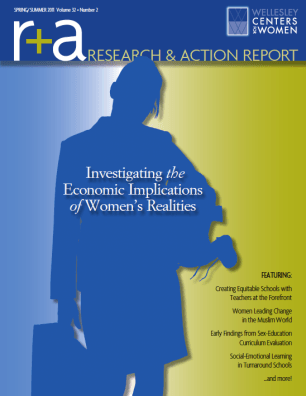Research & Action Report, Spring/Summer 2011
Sari Pekala Kerr, Ph.D., who arrived at the Wellesley Centers for Women (WCW) in 2010, brings not only experience in economic research and consulting in the U.S. to her work at WCW, but also expertise in analyzing economic effects of government policies in her homeland of Finland. That expertise became possible because of Finland’s remarkable record of demographic statistics, which reflect—in a breadth of detail that can amaze many—the experience of three generations of Finns. The Centers expect many of Kerr’s contributions to benefit from that research. Her newest project—supported by the Centers’ 35th Anniversary Fund—will study how maternity leave policies in both Finland and the United States affect women’s subsequent employment.
With experience in economic research in both Finland and the United States, you bring a special perspective to the work of Wellesley Centers for Women. What is your take on this perspective?
 I’m interested in looking at the economic effects of various public policies related to the labor market, or gender issues, or human capital development—particularly those effects related to families, children, and women in the workforce. I’m especially interested in international studies. I think Europe, in particular, has a lot of policy lessons that the U.S. can learn from. Where I can be helpful is in bringing the analysis of policy effects into place with theories and methods. The Centers are a great place for collaborating on international work because people here are working on so many different issues in so many countries.
I’m interested in looking at the economic effects of various public policies related to the labor market, or gender issues, or human capital development—particularly those effects related to families, children, and women in the workforce. I’m especially interested in international studies. I think Europe, in particular, has a lot of policy lessons that the U.S. can learn from. Where I can be helpful is in bringing the analysis of policy effects into place with theories and methods. The Centers are a great place for collaborating on international work because people here are working on so many different issues in so many countries.
As an economist, how do you determine what work you need to be doing?
I’m not a macro economist, I’m a micro economist, and that guides me to work on issues that are relevant for individuals, families, and children. I usually look at the current debate, about things like education. For example, today’s big questions in Europe concern the PISA [Programme for International Student Assessment] studies about the educational performance of different countries. Every time a new PISA study comes out, educators and policy makers busily compare national rankings. This is a good example of an issue that needs to be better understood. It’s great to know how various countries are doing—but what factors explain why some countries are so successful in their educational policies and other countries are not?
Another factor is feasibility—what things can we do? Economists try to be very rigorous in terms of their analysis, and that includes trying to create comparisons. For example, we don’t just want to say, “Finland implemented this policy, and look, now their education system is doing so well.” There’s no control group in that. So we would like to find a policy that’s been implemented in a way that lets us define a clear “control group” and a clear “treatment group”—almost like a drug or medical trial. That often helps us say something confidently about any causal relationships. It doesn’t mean we can’t say anything in other cases, but we need to be clear: “We see this connection, but we don’t know whether there’s any kind of causeand- effect relationship.”
Let’s talk more about educa tion in Finland. You’ve analyzed the relationship between levels of educa tion and levels of earnings among generations of Finnish families. What’s the background of this research?
 Beginning in the 1950s, Finland went through a very rapid change from being an agricultural country to becoming more manufacturing and services oriented, and the authorities soon realized that the skill level of the population was not where it needed to be to allow a successful transition. Finland’s older generation had among the lowest levels of education in Europe, and our grandparents always talked about having to walk or ski long distances to school. Some children in rural areas never got any schooling at all, or there would be a “circulating” school that came to the village once a month. My grandma always talked about this: “Oh, I was circulated twice, and that was even in the wrong direction!” [Laugh.] She was a very smart woman, but she got almost no schooling because she was living in a rural area and it wasn’t available.
Beginning in the 1950s, Finland went through a very rapid change from being an agricultural country to becoming more manufacturing and services oriented, and the authorities soon realized that the skill level of the population was not where it needed to be to allow a successful transition. Finland’s older generation had among the lowest levels of education in Europe, and our grandparents always talked about having to walk or ski long distances to school. Some children in rural areas never got any schooling at all, or there would be a “circulating” school that came to the village once a month. My grandma always talked about this: “Oh, I was circulated twice, and that was even in the wrong direction!” [Laugh.] She was a very smart woman, but she got almost no schooling because she was living in a rural area and it wasn’t available.
So the government decided to build many more schools—and to get rid of the tracking system. The Finnish school system had an academic track and a non-academic track, as some other European countries, like Germany, still do. When children were eleven, parents and teachers together decided which children should follow which track. In the early 1970s, the comprehensive school system was adopted, where all children go to public school together till the age of 16, following the same national curriculum, with teachers prepared under the same extremely high standard of teacher training. After that, students were eligible to apply to an academic high school or to a vocational school. The goal was to provide equal educational opportunity.
A lot of people said, “This is never going to work; you’re going to force these children who don’t have the capability through this academic curriculum, and it’s going to be harmful for them later on. Plus, it’s going to harm the very gifted children who have to be in the same classroom with pupils who aren’t interested in the academics.”
What did your research show?
We found that, when the tracking system was removed and the comprehensive system started, there was a very rapid and sizeable increase in economic mobility from generation to generation. In other words, children were able to do better economically regardless of the economic status of their family of origin. We don’t see that the more academic children were seriously harmed by this and we do see that the children who would have been shut out previously actually did remarkably well. It looks like a great success story. You start from a very low-educated population and end up with one of the best-educated populations in the world. One of our reports was published last year in Europe’s Journal of Public Economics and has received a fair amount of publicity. Germany right now is in a fierce political debate about school reform, and people have been very interested in learning more about the comprehensive schools.
That kind of transformation must have been extremely expensive.
I did a study—and it did cost a lot. But Finns are used to having high taxes; and every time you talk about cutting funding from schools, people get very angry. They’re happy to pay taxes if they think the money’s well spent. They don’t like spending it on things like people who don’t want to work; but roads, schools, things like that—no complaint! It’s such a different mindset.
How did Finland develop the rich sources of data that have allowed your studies there to be so useful?
This is where a lot of U.S. scholars find things getting scary. Like every other country, Finland used to have censuses. Then, in the 1960s, the government introduced social security numbers—which in Finland cover basically everything. Now censuses aren’t needed any more; the social security numbers fully identify you across all systems, all “registers” as they’re called. My husband and I were in Finland this fall and needed a phone line. When I was arranging it, they said, “What’s your social security number?” They didn’t ask for my credit card or anything, they just said, “Here are your phones!”
There’s a staggering number of registers—for taxes, education, housing, population, birth and death, employment, marriage, health, and so on. Eventually all this information could simply be pulled together annually using the social security numbers.
So now we have this amazing data set for three generations— grandparents, parents, and children—during a period of enormous economic and social change.
How might this information be helpful in your work here at the Centers?
As general lessons, I believe. Information in the U.S. is wonderfully available, but the types of data are limited and don’t necessarily follow up on a large enough number of people to enable researchers to say 20 years later whether or not some policy was effective. That’s where I think the Scandinavian countries can give us in the U.S. very good lessons from very rich register data that’s available almost nowhere else.
Let’s turn to a recent project in the U.S., your study of the economic effects of “Work First,” Detroit’s welfare-to-work program. In the current period of recession, this is certainly a timely issue. What was that project designed to discover?
For a long time many policy makers have thought that if people are unemployed, giving them even temporary-help jobs is good for them—that long periods of unemployment have a lot of negatives associated with them, including a negative impact on people’s careers; and so any kind of job must be better than that. But others have been skeptical about temporary-help jobs, arguing that they don’t provide security, they’re certainly associated with lower wages, employers don’t spend time training temp workers, and so on. And people can get stuck in a cycle of temp jobs, never getting into a regular one.
Our study was intended to discover what happened to the earnings of welfare recipients who had been placed in temp-help jobs as compared with the earnings of people placed in directhire positions. In other words, in each of the two groups, we compared the subsequent earnings of the individuals (almost all of whom were women) to their previous earnings. Data collection was done by the city of Detroit.
The program design involved a variety of placement contractors who functioned in a way that actually gave us “treatment” and “control” groups, so we could really get meaningful comparisons.
What did you learn?
We found that the direct-hire jobs, not very surprisingly, led to positive-looking long-term outcomes. Nobody’s earnings were harmed by them, and about half of the women were benefitting from the direct-hire jobs after one or two years, which was as long as we were looking.
The temporary-help jobs didn’t look like that at all. People at the lower end of the earnings distribution were being neither helped nor harmed, but people at the upper end actually suffered from being in temp-help jobs—some of them substantially. Our take on that is that those people, based on their characteristics of education, age, and previous history, probably would have found better jobs at some point on their own—and the lower-paying temp jobs may have been distracting them from their own job searches without leading them into anything long-term or helpful. It was striking, the bad effect on the upper-advantaged.
We cannot fully generalize these results, though; this sample is unemployed welfare recipients in Detroit, where we are talking about fairly disadvantaged people to begin with.
What implications might this have for U.S. policy makers, at any level?
What we take away as a policy lesson is that it’s not a good idea to think that getting people off welfare into just any kind of jobs is going to do them some good in the long run. When we spend money on contractors who are trying to help people find jobs, it’s worth thinking about the kinds of jobs we should be focusing on. But I should add that we’re not saying temp-help placements will not work for anyone, because again our study was specific, we were looking at Detroit. On the other hand, the unemployed welfare recipients in many areas of the country look similar to those in Detroit, making us believe that the policy lessons learned here are valid elsewhere as well.
How is this study being disseminated? Who has heard about it?
Currently we’re finalizing the basic manuscript. I’ve presented at a couple of seminars, and we’re submitting it for a couple of conferences. We’re gathering feedback and criticisms from other academics, and hopefully this spring we’ll submit it to an academic journal for peer review; then we’ll see where it goes from there. Certainly the city of Detroit is interested in it. My co-author spoke about it this fall on an NPR [National Public Radio] interview that attracted a lot of interest, and I think it’s going to attract more once we bring out the results.
Tell us about your new research project for WCW, funded in part by the Centers’ 35th Anniversary Fund, which will study the effects of maternity leave policies in Finland and the United States.
I want to look at the effects of those policies on women’s later work careers. Of course, there are various policies involved. In the U.S. there are the FMLA (Family and Medical Leave Act), passed in 1993, and the various state and local policies. FMLA covers only employers who have more than 50 employees; so if you work for a smaller employer, you may not be covered, unless your state has a separate mandate that requires it.
We want to match these policies with the women they affect to see how much leave the women actually take, and then later on see how that length of time away from work affects their labor-market careers. And we want to have a pretty wide-ranging view of those effects—not just on people’s earnings, but whether they return to the same employer, how soon they return, whether they are later unemployed at any time, as well as any hiring, firing, or promoting that subsequently occurs.
In Finland, there was no national policy about maternity leave until the early ’70s. After that, the specified length of leave was gradually increased from one month to three months, and so on, until by the early ’80s it was one year. There were also other changes, including provisions for paternal leave. Because of all those gradual changes, we can compare the effects of leaves of different lengths. We can also improve on the U.S. part of the study by, in this Finnish part, comparing the effects on men versus women. It often is argued that men who take paternity leave aren’t afterward negatively affected the same way as women may be.
In the Finnish study, for which we expect to receive Finnish funding, the extensive national data will also allow us to see how employers are affected, in costs and productivity. When we’re trying to plan parental leave policies that are good both for families and the economy, we have to understand what happens to the firms as well. If we’re going to give 12 months of leave to everyone and it’s going to have a seriously harmful effect on the firms, as demonstrated by their subsequent financial data, then Finland will have to figure out a way of compensating the firms as well.
How long will the study take?
Hopefully we’ll have some results from the U.S. study by early next spring. A lot of the work is going to take place this fall. I’d like to start earlier, but I have to do my own maternity leave first! I’m going to do the wonderful three-month thing. Everyone is saying, “Aren’t you wishing you were in Finland now?,” and I’m like, “Oh, don’t even get me started!” I must say, though, that a lot of the researchers in Finland have a hard time, knowing that they will be gone from work for a year.
Will your results include a comparison between the two countries?
There’s too much variation for a direct comparison. But for both countries we’ll hopefully offer some very clear implications of the effects of maternity leave policies on the women’s careers.
And I think the Finland experience will have lessons for the U.S. In terms of the protection of women’s jobs during family leave, Finland started where the U.S. is right now and then went much farther. So perhaps we’ll be able to say this might be what the U.S. could look like if we decided to provide more leave time here.


